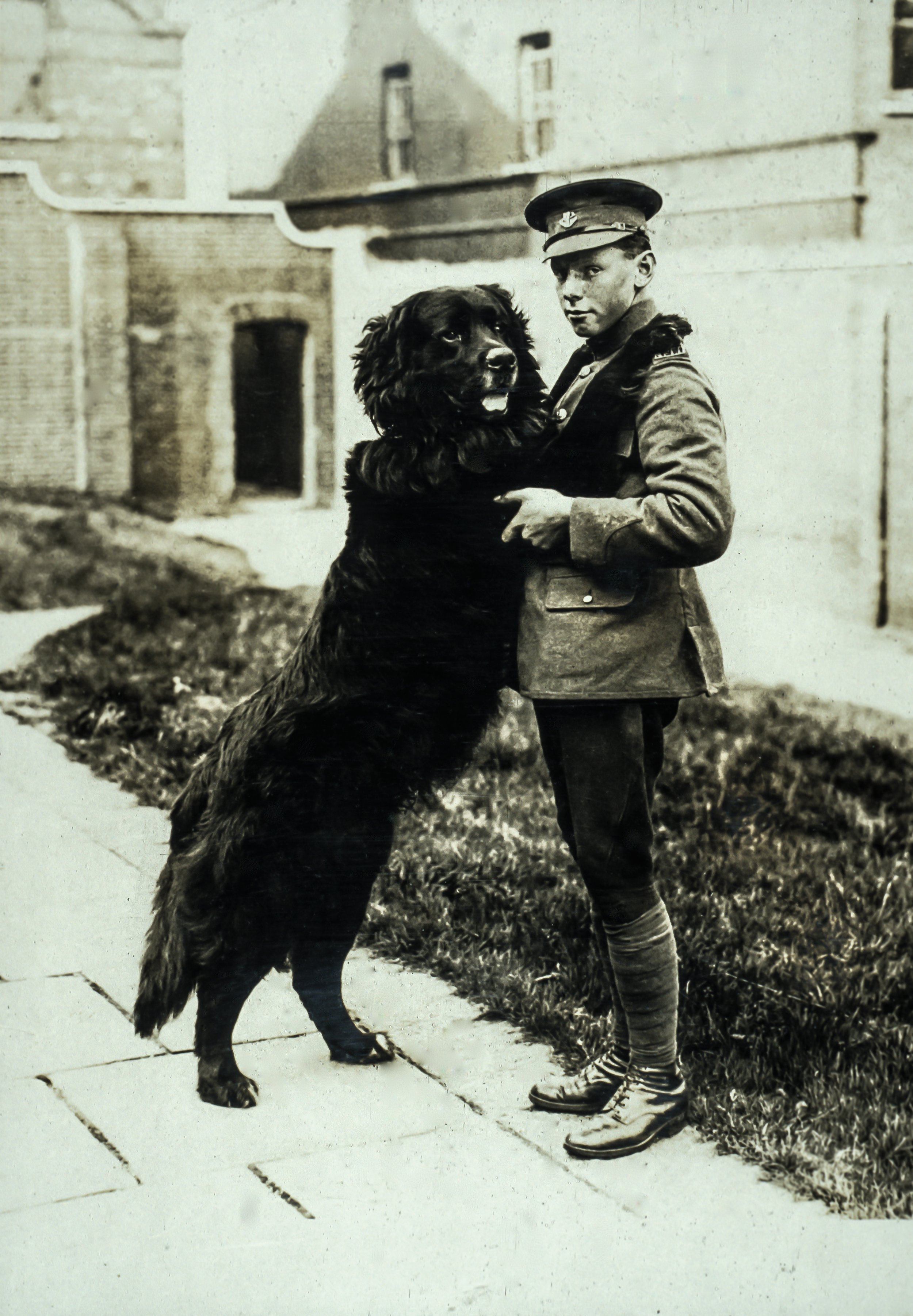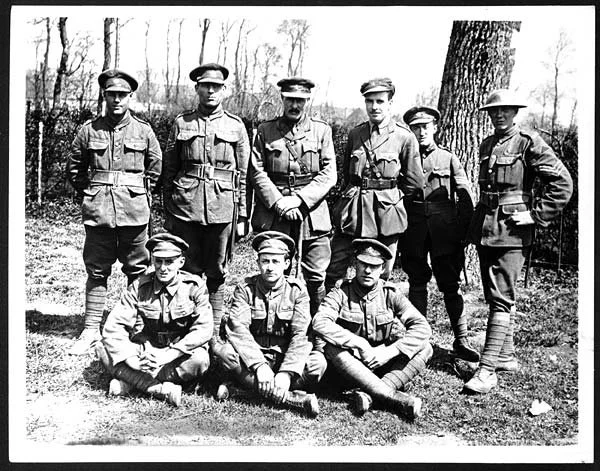Sable Chief: The Newfoundland Dog Who Served in WWI
Sable Chief was a mascot of the Royal Newfoundland Regiment during the First World War but, as anyone who served with him would have told you, he was far more than that.
He marched when they marched, lifted their spirits when nothing else could, and made them feel a little closer to home.
And when he died, it broke their hearts.
This is his story.
The Story of Sable Chief
By 1917 the men of the Royal Newfoundland Regiment were scattered across the Europe, fighting in the First World War.
Some were serving on the front lines in Flanders. Others were recovering in hospitals in England. More were training in Scotland — learning to march in step, bury their homesickness, and become the soldiers they knew they needed to be.
It was terrible time.
What they didn’t know was that a dog was about to do for them what no officer, drill sergeant, or chaplain could. He was going to bring comfort without question, loyalty without judgment, and remind them — in the softest way possible — of the world they were missing.
An Unexpected Gift
He arrived as a gift in the spring of 1917 — a massive, black Newfoundland dog, presented to the 2nd Battalion of the Royal Newfoundland Regiment at their camp in Ayr, Scotland. The gesture had been arranged through the efforts of Sir Edgar Bowring, and carried out by Captain C.W. Firebrace, a Canadian officer serving overseas.
Sable Chief with his handler, Private Hazen Fraser. Photographer unknown
The dog was barely more than a puppy, really — but already massive. Weighing well over 150 pounds, he was heavier than many of the boys in the Regiment. He could easily rest his front paws on their shoulders, look them in the eyes and give them a big, wet lick on the cheek.
They called him Sable Chief, and he was to be their mascot.
Sable Chief took the role seriously. He went where they went, and did what they did.
On the parade square, he moved with the soldiers — marching beside them, head high, tail proud. And when the anthem played, he would rise to his feet and stand perfectly still until the final note faded.
As if he understood.
And in time, the men understood — that Sable Chief didn’t just stand for them, he stood with them. He may have started as a symbol of the Regiment — but by then, he wasn’t a symbol at all. He was one of them.
“Everybody loved Sable, and he looked a Chief indeed as he marched along…”
Off duty, his good nature brought some much-needed light to the camp. He’d roughhouse with the boys, sprawl in the shade outside the orderly room, or curl up beside the barracks.
He brought the kind of comfort only a dog can — quiet companionship, offered with a gentle heart, and free of any conditions.
Years after the war, one soldier remembered him fondly, “Everybody loved Sable, and he looked a Chief indeed as he marched along…”
A Moment of Glory
That summer, the Regiment band was sent on tour playing in London, Liverpool, Sheffield, and visiting hospitals filled with wounded men.
And wherever the band went, Sable Chief marched too — led by his young handler, Private Hazen Fraser. Sable always carried a collection box round his neck to raise money for the Red Cross Prisoners of War Fund.
At His Majesty’s Theatre, he helped fill the hall and donations swelled. At Wandsworth Hospital, soldiers cheered just to see him again. He became a story in the papers, and a sensation wherever he went.
“The women crowded around good, patient Sable Chief,” one journalist reported, “until Mr. Worthington [the band master] had to beg them, "Don't suffocate the dog!”
At another stop eager parents tried to sit their children on Sable Chief’s back. Time and time again Sable Chief shook them off, until he finally barked as if saying he was a “no sitter,” one London paper joked.
“Sable Chief receives so much adulation,” came another report, “that he takes it all with philosophic calm.”
He had long since captured the hearts of his Regiment. Now, it seemed, the rest of England was following suit.
A Dark Day
By early 1918, the war still dragged on. The Regiment had moved to Hazeley Down Camp near Winchester.
And Sable Chief was there, too — striding through camp like he owned the place.
Until, suddenly, he was gone.
A driver wasn’t playing attention and just like that, the dog who had carried their morale of the Newfoundland troops was killed by a military transport.
The Regiment was heartbroken.
He’d been with them little more than a year and a half and the loss hit hard, and all due to “The stupidity of a lorry-driver,” as one soldier described it, years later.
Still Standing
Sable Chief may never have fought in battle, but he was important part of the war effort all the same.
He stood on parade grounds and theatre stages. He stood beside the wounded, the homesick, the grieving. And when the anthem played, he showed them how to stand still — how to hold fast in a world where everything else seemed to be falling apart.
After he died, his body was sent to a taxidermist in the hope of preserving him — but the result disappointed many who had known him in life.
“Sable Chief deserved better,” one soldier wrote.
He did.
Today, what remains of Sable Chief is at The Rooms in St. John’s — restored and preserved. But I’m sure those who knew him would tell you: the real Sable Chief isn’t there.
You can’t preserve loyalty. You can’t stuff what made him matter.
He marched with the boys of the Regiment. He gave them comfort, lifted their hearts, and stood beside them when they needed it most.
He was a ‘good boy’ in the Great War — and he died far too soon.
-
The Royal Newfoundland Regiment Scrapbook (book 1), MUN Digital Archives
Harvey M. Skirving Scrapbook 2, MUN Digital Archives
The Fighting Newfoundlander : A History of the Royal Newfoundland Regiment, Gerald W. L. Nicholson, 1964
Newfoundland Dog Regiment’s Mascot, The Evening Telegram, November 8, 1975
The Re-Discovery of Newfoundland, The Evening Herald, November 1, 1917
Sable Chief, The Newfoundland Club of America
The Searchlight, The St. John’s Daily Star, May 23, 1919
Sable Chief - A Comforting Mascot, Veterans Affairs, Canada
Ruby Ayre Photograph Album, MUN Digital Archives
Sable Chief and Pte. Hazen Fraser, The Royal Newfoundland Regiment Museum
Reminiscences of the Second (Reserve) Battalion by No. 142, The Veteran Magazine, July 1923
Sable Chief in Plastic, Atlantic Guardian, vol. 07, no. 07 (July 1950)
Artifacts of The Royal Newfoundland Regiment, Canadian Geographic, July 6, 2016
Hero in Plush and Plastic
If you find yourself at The Rooms in St. John’s and feel the tug of nostalgia, you can bring home a 12-inch plush version of Sable Chief — exclusive to the gift shop. He’s soft, well-behaved, and probably won’t shed much.
The first attempt to immortalize him came much earlier. In the late 1940s, Bonavista war veteran H. J. Fisher captured the famous dog in “plastic stone” — a collectible ornament showing Sable Chief in a relaxed pose, black with grey eyes and a pink tongue, resting on an eight-inch grey base. Each one came wrapped in Cellophane, boxed up with a short write-up on his life and legacy.
I’m not sure how many were made, but they seemed to hit store shelves in fall 1949.
If you happen to own one — or find one tucked away on a shelf somewhere — I’d love to see it. Snap a photo and tag @productofnfld.
Sable Chief deserves his moment in the spotlight. Again.


